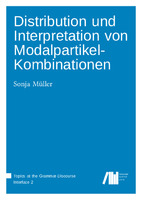Distribution und Interpretation von Modalpartikel-Kombinationen
| dc.contributor.author | Müller, Sonja | |
| dc.date.accessioned | 2018-10-11 23:55 | |
| dc.date.accessioned | 2020-03-10 03:00:38 | |
| dc.date.accessioned | 2020-04-01T12:20:04Z | |
| dc.date.available | 2020-04-01T12:20:04Z | |
| dc.date.issued | 2018-05-28 | |
| dc.identifier | 1001676 | |
| dc.identifier | OCN: 1065536325 | en_US |
| dc.identifier.uri | http://library.oapen.org/handle/20.500.12657/28286 | |
| dc.description.abstract | The subject of this piece of work is the combination of the modal particles ja and doch, halt and eben as well as doch and auch. Based on empirical investigation (acceptability studies, corpus searches) and a formal modelling of the meaning of the single particles as well as their sequences within the discourse model by Farkas & Bruce (2010), this work proposes an iconic explanation of the observed sequencing preferences. It is argued that the preferred sequences show the unmarked orders. However, one should act on the assumption that marked sequences exist as well. These are less acceptable, occur more infrequently and are restricted to certain contexts. These contexts are identified and integrated into the explanation of the preferences. | |
| dc.language | German | |
| dc.relation.ispartofseries | Topics at the Grammar-Discourse Interface | |
| dc.subject.other | Linguistics | |
| dc.title | Distribution und Interpretation von Modalpartikel-Kombinationen | |
| dc.type | book | |
| oapen.identifier.doi | 10.5281/zenodo.1244028 | |
| oapen.relation.isPublishedBy | 0bad921f-3055-43b9-a9f1-ea5b2d949173 | |
| oapen.relation.isFundedBy | b818ba9d-2dd9-4fd7-a364-7f305aef7ee9 | |
| oapen.relation.isbn | 9783961100873 | |
| oapen.collection | Knowledge Unlatched (KU) | |
| oapen.place.publication | Berlin | |
| oapen.grant.number | 103591 | |
| oapen.grant.program | Language Science Press 2018 - 2020 | |
| oapen.identifier.isbn | 9783961100873 | |
| grantor.number | 103591 | |
| oapen.identifier.ocn | 1065536325 |

